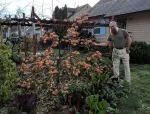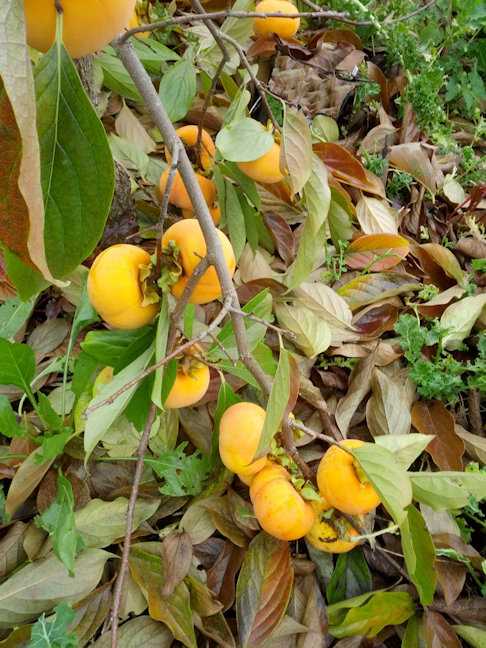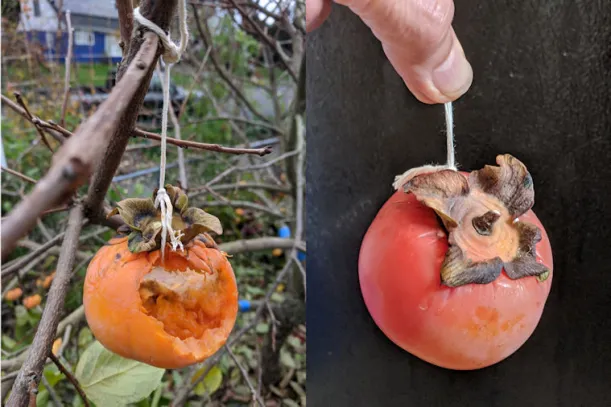Persimmon trees are eminently suited for training to small size.
I recently read the book “Grow a Little Fruit Tree” by Ann Ralph. I am in complete agreement on the principles, but I was surprised the author “excuses” persimmon trees. “Oh, let them grow big,” was the plea, “They’re so beautiful in the fall!”
Well my little persimmon tree gets a lot more attention in the autumn, because it is so small. Persimmons are widely planted across Portland. People put one in, then just let it go. All summer, it blends into the background amidst the rest of the green. In fall, it drops its leaves to reveal the bounty of orange globes — too high to reach.
I planted my persimmon tree in April 2014. In 2016, when scarcely more than six feet tall, it bore its first crop. I didn’t realize what was going on until the leaves fell off. Eighty persimmons on that small tree!
One day I was looking out the window. A little Asian lady walking along the sidewalk stopped dead in her tracks to stare. I’m not the only one to appreciate small fruit trees!
I had seen persimmon trees in yards in California, grown tall and skinny, all the fruit perched two stories high. I was determined not to let mine get away. I agree with the philosophy of “Grow a Little Fruit Tree”, but I have a difference of technique. I was not about to chop my tree off six inches above the ground, or whatever it was. No, I liked the growth up to six feet. I just wasn’t going to let it get any taller.
Most fruiting trees, such as apples, pears, peaches, plums, and cherries, bear fruit on existing branches. The flowers pop out of buds that formed the previous year, then stayed dormant through winter. Persimmons are different. If you look at a leafless tree in winter, you will find no fruit buds. Where do the persimmons come from?
Only when new leafy shoots grow out in spring do flower buds develop in the axils of the leaves. These buds open into small four-petaled flowers, typically creamy white. These flowers are rather inconspicuous, especially since by then the tree is well covered in leaves.
The salient point for tree size is that, in order for your persimmon tree to have fruit, it has to make fairly extensive growth of new shoots. These can be upward, but if you plan ahead you can make them mostly go outward.
My experience is that persimmons form fruit buds on all new growth. If anything, more on the outward-spreading shoots, relative to the uprights. So you are not losing anything by taking out the verticals.
I mostly use the technique of “drop crotch”-ing. I cut back to the point where a branch divides in two, a crotch. I take out the more vertical side.
To keep a tree short, I am always thinking about reach height. Simply, the height to which I can reach, while standing on the ground. Since a persimmon has to grow new shoots in order to fruit, I want the results of winter pruning to be below reach height, because that’s where spring growth will start.
Some of the uprights on my tree were getting rather large, more than an inch in diameter. The best available crotches had side branching less than half that size. I thought, if I cut off such vigorous limbs, I might induce the tree to shoot out a thicket of water sprouts from that point. To my surprise, this did not happen. The tree was perfectly satisfied to re-direct its growth mostly in the wide spreading direction.
In all tree pruning, you have to think ahead. If your persimmon tree has already grown tall, so the the only thing at reach height is the trunk, you’re going to have a hard time making it small again. Better to start before it gets tall in the first place.
So I have managed to keep my persimmon tree small, much to the incredulity of some. There have even been visitors who couldn’t believe those really were persimmons, on a mere bush. The crops have not been mere. Below is a picture of the tree in 2018. More than 350 fruit, and I could reach them all.
Well, 350 was what I tallied. A friend in the neighborhood later casually mentioned he’d been helping himself. I asked, about how many? Maybe fifty. So there may have been considerably more.
Some Portland persimmon tree owners finally haul out the ladder in late fall, when they notice the fruit is getting pecked by birds. Others give up and don’t bother, because the birds have pecked everything.
Out of my 350 persimmons, only 13 were pecked, most at the very top of the tree. Birds prefer to stay as high as possible. They know danger for them lurks on the ground.
Lately, I have been making a “deal” with the birds, which seems to work. Birds don’t eat much. It’s a matter of convincing them to stick to a few persimmons, instead of pecking a little out of a lot of them, which makes the fruit rot.
There are always some fruits I am not going to eat. They got damaged, or something. Also, when the birds work on one, before long it falls off, and then the birds are scared to go to the ground and eat any more of it.
So, I take some of these damaged fruits, and tie them high up in the tree. The birds seem satisfied to keep pecking at those, and for the most part leave the lower ones alone.
The birds that visit most are crows. I like crows, and so I don’t mind if they take a few persimmons. I have yet to get a picture of them at it, but the crows seem to prefer fruit they can reach while standing on a nearby perch. So I try to hang the bird fruit where there is a convenient twig below, sturdy enough for a crow.
Since my tree is short, I can tie the offerings while standing on the ground.












